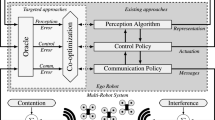Abstract
Establishing a large adaptive connected network for decentralized swarms is useful for their behavior to share information about the working environment. A hard-coded implementation is time-consuming to achieve. Therefore, we are motivated to explore the benefits of reinforcement learning (RL) to learn a suitable adaptive policy. We also explore the combined use of a scalar field, which was inspired by template pheromones in social insects. In this paper, we investigate using RL with low and high-resolution scalar fields to solve the largest covering network problem. Our results show that RL outperforms the hard-coded approach in the presence of the high-resolution scalar field.










Similar content being viewed by others
References
Panerati J, Gianoli L, Pinciroli C, Shabah A, Nicolescu G, Beltrame G (2018) From Swarms to Stars: Task Coverage in Robot Swarms with Connectivity Constraints, 2018 IEEE International Conference on Robotics and Automation (ICRA), pp. 7674-7681
Francesca Gianpiero, Brambilla Manuele, Brutschy Arne, Garattoni Lorenzo, Miletitch Roman, Podevijn Gaëtan, Reina Andreagiovanni et al (2015) AutoMoDe-Chocolate: automatic design of control software for robot swarms. Swarm Intell 9(2):125–152
Mitaka Y, Akino T (2021) A review of termite pheromones: multifaceted, context-dependent, and rational chemical communications. Front Ecol Evol. https://doi.org/10.3389/fevo.2020.595614
Eric B, Marco D, Guy T (2020) Swarm intelligence: from natural to artificial systems swarm intelligence: from natural to artificial systems self-organization and templates: application to data analysis and graph partitioning. In: Swarm intelligence: from natural to artificial systems. Oxford University Press (Oxford Scholarship Online (1999))
Vardy Andrew (2018) Orbital construction: Swarms of simple robots building enclosures. In 2018 IEEE 3rd International Workshops on Foundations and Applications of Self* Systems (FAS* W), IEEE, pp. 147-153
Strickland Caroline, Churchill David, Vardy Andrew (2019) A reinforcement learning approach to multi-robot planar construction. In 2019 International Symposium on Multi-Robot and Multi-Agent Systems (MRS),IEEE, pp. 238-244
Bajaj D Manju (2014) Maximum coverage heuristics (MCH) for target coverage problem in Wireless Sensor Network, 2014 IEEE International Advance Computing Conference (IACC), pp. 300-305
Cardei M, Du DZ (2005) Improving wireless sensor network lifetime through power aware organization. ACM Wirel Netw 11(3):333–40
Szepesvári Csaba (2010) Algorithms for reinforcement learning. Synth Lect Artif Intell Mach Learn 4(1):1–103
Vardy Andrew, Ibrahim Dalia S (2020) A swarm of simple robots constructing planar shapes. arXiv preprint arXiv:2004.13888
Author information
Authors and Affiliations
Corresponding author
Additional information
Publisher's Note
Springer Nature remains neutral with regard to jurisdictional claims in published maps and institutional affiliations.
This work was presented in part at the joint symposium of the 27th International Symposium on Artificial Life and Robotics, the 7th International Symposium on BioComplexity, and the 5th International Symposium on Swarm Behavior and Bio-Inspired Robotics (Online, January 25-27, 2022).
About this article
Cite this article
Ibrahim, D.S., Vardy, A. Largest coverage network in a robot swarm using reinforcement learning. Artif Life Robotics 27, 652–662 (2022). https://doi.org/10.1007/s10015-022-00804-4
Received:
Accepted:
Published:
Issue Date:
DOI: https://doi.org/10.1007/s10015-022-00804-4




